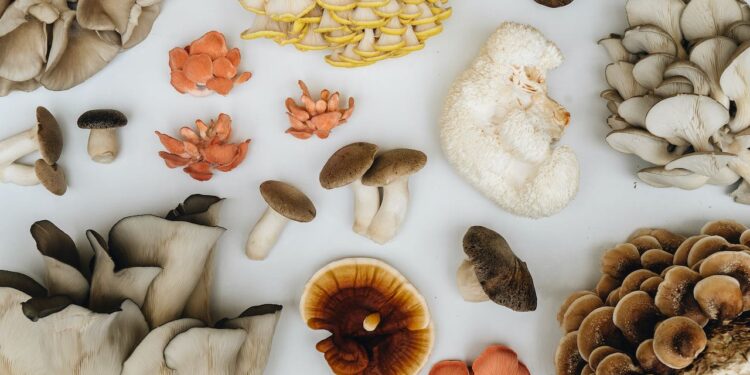Growing your food is a rewarding experience that allows you to become more self-sufficient and reduce your environmental impact. One of the easiest and most versatile crops to grow at home is oyster mushrooms, specifically white oyster mushrooms and pink oyster mushrooms.
These delicious and nutritious fungi can be grown all year round with minimal effort. This makes them the perfect addition to any beginner’s home cultivation journey.
Whether you have a green thumb or are new to gardening, this guide will provide the necessary knowledge and steps to grow oyster mushrooms successfully at home.
So, let’s dive in and learn how to grow oyster mushrooms. Let’s begin!
Table of Contents
Choose a Growing Method
Before starting your oyster mushroom growing journey, deciding on a suitable cultivation method is essential. Oyster mushrooms can be grown indoors or outdoors, using either logs, straw, or sawdust as a growing medium.
Logs Method
Growing oyster mushrooms on logs is a traditional and natural method. You must source fresh hardwood logs, such as oak or beech, and inoculate them with spawn (mushroom seeds). The logs should then be kept in a cool, shady place until the mushrooms start to appear.
Straw Method
This method involves growing oyster mushrooms on straw soaked in water and sterilized. The straw is mixed with spawn and placed in a plastic bag or container to grow.
Sawdust Method
Growing oyster mushrooms on sawdust is the most common method for home cultivation. Sawdust can be sourced from any hardwood tree, mixed with spawn, and placed in a plastic bag or container.
These methods differ in terms of cost, time, and effort required. For beginners, we recommend starting with a simple method, such as using sawdust blocks or straw bags.
Select Oyster Mushroom Variety
There are various types of oyster mushrooms, but the most common and beginner-friendly varieties are white oyster mushrooms and pink oyster mushrooms. These two types have similar growing requirements and produce tasty and abundant harvests.
White oyster mushrooms have a mild flavor and can be used in various dishes like stir-fries and soups or as a meat substitute. On the other hand, pink oyster mushrooms have a seafood-like taste and are perfect for adding to pasta dishes or risotto.
Gather Supplies
Gather your supplies before starting the growing process. You will need oyster mushroom spawn, a suitable growing medium (such as sawdust or straw), and containers or bags to grow them in.
If you are using logs, ensure they are freshly cut and free of insect damage. For sawdust blocks, use hardwood sawdust for best results. And if using straw bags, make sure to use straws that are free of pesticides and other chemical treatments.
If you want a complete set of supplies, consider investing in an Oyster Mushroom grow kit containing all the necessary materials and instructions for growing oyster mushrooms at home.
Prepare the Substrate
The substrate is the material on which the oyster mushrooms will grow. For sawdust and straw methods, the substrate must be pasteurized by boiling or soaking in hot water for several hours.
Once cooled, drain excess water and mix in the mushroom spawn thoroughly. This process ensures that any potential competitors are eliminated before inoculating with mushroom spawn.
Inoculate With Spawn
After preparing the substrate, it’s time to inoculate with mushroom spawn. The spawn can be purchased online or from local gardening stores.
Make small holes in the substrate and evenly distribute the spawn throughout. The spawn will act as a seed for the mushrooms to grow on.
Incubation Period
Place the inoculated substrate in a warm, dark space like a closet or cupboard. Oyster mushrooms prefer temperatures between 20-25 degrees Celsius.
During this incubation period, the mycelium (the vegetative part of the fungus) will colonize the substrate and form a network of white tendrils.
Introduce Fresh Air and Light
After the mycelium has fully colonized the substrate, introduce fresh air and light to initiate fruiting. This can be as simple as poking holes in a plastic bag or loosening the lid of a container.
Place the bags or containers in a well-ventilated area with indirect sunlight. Within a few days, tiny mushroom pins will start to form. These pins will grow into full-sized mushrooms with proper care and maintenance in about two weeks.
Maintain Humidity and Moisture
Oyster mushrooms require high levels of humidity and moisture to grow. To maintain this environment, lightly mist the growing area with water a few times daily.
If using logs or straws, soak them in water every few days. Properly hydrated mushrooms will have firm and plump caps.
Harvesting
Once the mushrooms have reached their desired size, it’s time to harvest them. Gently twist and pull the mushrooms from the substrate or log.
Harvesting should be done when the caps are still slightly curled under, as they will continue to grow after harvesting. The remaining mycelium can produce a second flush of mushrooms in a few weeks.
Repeat the Process
After harvesting, you can repeat the process to grow a new batch of oyster mushrooms. Each harvest will give you more experience and knowledge in growing these delicious fungi.
Repeating the process also ensures a steady supply of fresh and nutritious oyster mushrooms for your cooking needs. Plus, it’s a fun and satisfying hobby that brings you one step closer to self-sufficiency.
Learn How to Grow Oyster Mushrooms From Home
If you are planning to grow oyster mushrooms at home, this guide has provided you with the essential knowledge and steps to get started. Remember to choose a suitable method, select the right variety, prepare the substrate properly, and maintain ideal growing conditions.
With patience and dedication, you will soon be enjoying your own homegrown white oyster mushrooms or pink oyster mushrooms in all your favorite dishes. So why not unlock the world of home cultivation and start your journey with oyster mushrooms today?
Let’s grow oyster mushrooms together!
If you wish to read more articles besides learning about growing mushroom plants at home, visit our blog. We’ve got more for you!


 Home
Home










